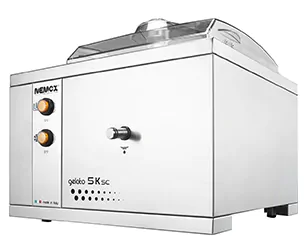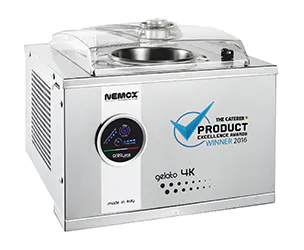Commercial Ice Cream Maker Buying Guide


Commercial ice cream makers return their initial capital quicker than most other kitchen products. Choosing the correct style and size of the machine is important to maximise profit from gelato in your restaurant. Ice cream, gelato or sorbets are the most popular dessert in the UK and will also be served alongside many classic desserts. Adding "Homemade" ice cream to your menu will certainly grab your customer's attention and get them coming back for more.
Below is our buying guide for commercial ice cream makers.
How Does a Commercial Ice Cream Machine Work?
Commercial ice cream machines work by mixing, cooling, and churning the ice cream mixture to create a smooth and creamy texture. Here's a general overview of how they work:
- Mixing: The ice cream machine starts by combining the ice cream base ingredients, such as milk, cream, sugar, and flavourings, in a mixing chamber or hopper. Some machines may also have separate mix and freezing chambers.
- Cooling: Once the ingredients are mixed, the mixture is cooled to a specific temperature, typically around -4°C to -6°C (25°F to 21°F). This cooling process is crucial for preventing the formation of large ice crystals and ensuring a smooth texture.
- Churning: As the mixture is cooled, the machine simultaneously churns it. Churning incorporates air into the mixture, which helps give the ice cream its light and fluffy texture. The agitation also prevents the formation of large ice crystals by continuously breaking them apart as they start to form.
- Freezing: As the mixture continues to churn, it gradually freezes into ice cream. The freezing process is aided by the low temperature maintained by the machine and the constant churning motion, which promotes even freezing and distribution of air throughout the mixture.
- Extrusion: Once the ice cream reaches the desired consistency, it is extruded from the machine through a nozzle or dispenser. The freshly churned ice cream can then be served immediately or transferred to a storage container for later use.
Commercial ice cream machines may vary in design and features, but they all follow these basic principles to produce high-quality ice cream consistently. Some advanced machines may offer additional features, such as multiple flavour options, programmable settings, and built-in refrigeration systems to maintain the ice cream at the desired temperature until serving.


What’s the difference between a commercial and domestic ice cream maker?
- Commercial machines have a built in freezer. Many domestic machines only offer a motorised paddle and a bowl that needs to be placed in the freezer for a minimum of 8 hours before use.
- Warranty – The ice cream machines that we sell come with a 1 year onsite warranty as standard for UK customers. Report any problems with the machine and a certified engineer will be out to fix the machine in 48 hours. Ensuring you won’t be without it for long.
- Capacity – Commercial machines have larger capacities than domestic versions. Domestic ice cream makers might be able to keep up with a small families requirements but will never be able to produce enough to satisfy a restaurant.
- Speed – Commercial machines produce delicious gelato in minutes rather than hours. The built in freezer can cool mixtures far faster than relying on the residual cooling of the frozen bowl.
- Multi function – Commercial machines can be set to make both hard and soft ice cream, gelato, granita, sorbet, frozen yogurt amongst other consistencies at the touch of a button. The ability to control different cooling and mixing rates contribute to this.
- Density control switch – All Nemox machines come with a density control switch that stops the motor and the freezer when the density becomes too hard. This stops the machine damaging itself when motor cannot turn frozen paddles.
Different types of ice cream machine


Domestic Pre-freeze Ice Cream Maker
As we have covered above. Domestic machines predominantly require the user to prefreeze the bowl, have reduced capacity, take longer to finish and don’t have any options to control the consistency. These should be kept at home and out of the restaurant.


Commercial Manual Machines
Commercial manual machines offer larger capacities, speed and some control of consistency but lack intelligent or automatic functions seen in the automatic machines below. The Nemox machines we supply do come with a density control switch that stops the machine if the consistency becomes too hard so they will not damage themselves. A great option if you’re looking for a simple machine that performs.


Commercial Automatic Machines
Commercial automatic machines offer intelligent programs, the ability to control small changes in consistency or pre-set options for different types of ice cream. Another key benefit of the automatic machines are the set and forget functionality. The chef can fill the machine with the mixture set it and when they return the machine will have automatically kept the gelato at optimal consistency for serving.
Size Matters
Many of the most popular machines that we sell are counter mounted. Nemox saw a growing requirement for restaurants and gastro pubs with an ever changing menu for a lower number of covers. They didn’t need a large industrial machine but wanted the opportunity to create delicious “homemade” ice cream for their customers. The countertop machines are simply plug and play, easy to clean and fast to allow flexibility in the menu.
How long does it take to make ice cream?
The time required to make ice cream can vary significantly depending on the type of ice cream machine being used. For instance, Nemox machines, known for their efficiency and rapid freezing capabilities, can produce a batch of ice cream in as little as 12 minutes, thanks to their advanced technology and design. However, it's essential to note that while some machines prioritize speed, others may prioritize other factors such as texture, flavour, or production capacity. In general, the cost of the machine often correlates with its speed and capacity, with higher-priced models typically offering faster production times and larger batch sizes. Therefore, investing in a more expensive machine can result in quicker turnaround times and increased output, making it a worthwhile consideration for commercial establishments with high demand for ice cream products.


